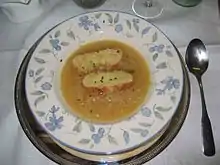French onion soup
French onion soup (French: soupe à l’oignon [sup a lɔɲɔ̃]) is a type of soup usually based on meat stock and onions, and often served gratinéed with croutons or a larger piece of bread covered with cheese floating on top. Although ancient in origin, the dish underwent a resurgence of popularity in the 1960s in the United States due to a greater interest in French cuisine. French onion soup may be served as a meal in itself or as a first course.[1]
 Bowl of French onion soup | |
| Alternative names | Onion soup |
|---|---|
| Course | Starter (entrée) |
| Place of origin | France |
| Region or state | All |
| Created by | Multiple claims |
| Serving temperature | Hot |
| Main ingredients | Onions, beef or chicken stock, croutons, grated cheese |
History
Onion soups have been popular at least as far back as Roman times. Throughout history, they were seen as food for poor people, as onions were plentiful and easy to grow. The modern version of this soup originates in Paris, France in the 18th century,[1][2] made from beef broth, and caramelized onions.
It was introduced to the United States by the New York restaurant of Henri Mouquin in 1861, where his wife Marie Julie Grandjean Mouquin was the chef.[3] It is often finished by being placed under a salamander in a ramekin with croutons and Comté melted on top. The crouton on top is reminiscent of ancient soups (see history of soup).
Preparation
Recipes for onion soup vary greatly:
Though the liquid is usually meat stock, it may be simply water. Milk may be added. It may be thickened with eggs or flour. It may be gratinéed or not.[4][5]
Generally, recipes specify that the onions should be cooked slowly, becoming caramelized. Brandy, sherry, or white wine is added at the end to deglaze. The soup base is often topped slices of (toasted) bread (a "croute" or "crouton").
For the gratinéed version, the croute is topped with cheese and broiled or baked. The soup is then immediately served in the bowl or ramekin in which it was broiled (grilled), baked, or—in family-style—immediately transferred to individual serving bowls via a ladle.
Alternative names
Some alternative names for the soup include:[2][6]
- Soupe à l'oignon à la Parisienne
- Gratinée Parisienne
- Gratinée des Halles
- Gratinée Lyonnaise
- Soupe à l'oignon Lyonnaise
- Soupe à l'oignon Gratinée
See also
References
- Olver, Lynne. "French onion soup". The Food Timeline.
- Frétillet, Jean-Paul (23 January 2015). "Dégustation : la soupe à l'oignon, bonne à en pleurer!". Le Parisien (in French). Retrieved 14 December 2016.
- Carter, Marion (December 27, 1933). "Odor of Onion Soup Lingers as Monument to Mouquin". New York Evening Journal.
- Robert Courtine, Derek Coltman, trans. (1973) The Hundred Glories of French Cooking. Farrar, Straus and Giroux. p. 18. ISBN 0374173575
- Marie Ébrard (1927) La bonne cuisine de Madame E. Saint-Ange, Editions Chaix. p. 186.
- Newman, Bryan G. (10 October 2014). "Soupe à l'Oignon - French Onion Soup. Ordering the Most Famous of all French Soups and the Difference Between Parisian and Lyonnais Onion Soups". Behind the French Menu. Retrieved 14 December 2016.
External links
 Onion Soup at Wikibook Cookbooks
Onion Soup at Wikibook Cookbooks
.jpg.webp)